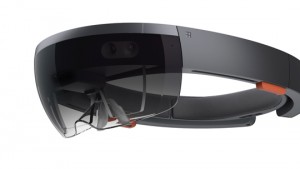Microsoft HoloLens

Windows Microsoft HoloLens is a Holographic is a “mixed reality” computing platform, enabling applications in which the live presentation of physical real-world elements is incorporated with that of virtual elements (referred to as “holograms” by Microsoft) such that they are perceived to exist together in a shared environment. A variant of Windows for augmented reality computers (which augment a real-world physical environment with virtual elements) Windows Holographic features an augmented-reality operating environment in which any Universal Windows App can run. In addition, with Holographic APIs, which are part of the Universal Windows Platform, and supported as standard in Windows 10 (including versions for mobile devices and Xbox One), mixed reality features can be readily implemented in any Universal Windows App, for a wide range of Windows 10-based devices.
Microsoft announced Windows Holographic at its “Windows 10: The Next Chapter” press event on January 21, 2015. Introduced through the smart glasses headset Microsoft HoloLens, as part of the general rollout of Windows 10. The Windows 10 launch began July 29, 2015 with release of the PC version, with the Microsoft HoloLens Development Edition released in the first quarter of 2016.

The premier device for Windows Holographic, Microsoft HoloLens is a smart-glasses headset that is a cordless, self-contained Windows 10 computer. It uses advanced sensors, a high-definition stereoscopic 3D optical head-mounted display, and spatial sound to allow for augmented reality applications, with a natural user interface that the user interacts with through gaze, voice, and hand gestures. Codenamed “Project Baraboo,” HoloLens had been in development for five years before its announcement in 2015, but was conceived earlier as the original pitch made in late 2007 for what would become the Kinect technology platform.
Microsoft has targeted Microsoft HoloLens for release “in the Windows 10 timeframe,” with the Microsoft HoloLens Development Edition the first quarter of 2016, available by application to developers in the United States and Canada for a list price of US$3000. Companies such as Samsung Electronics and Asus had expressed interest in working with Microsoft to produce their own mixed-reality products based on HoloLens.
The Microsoft HoloLens design is of a visor glasses unit connected to an adjustable padded inner headband. The unit can be tilted up and down, as well as adjusted forward and backward in relation to the headband. To wear the HoloLens, the user uses an adjustment wheel at the back of the headband to secure it around the crown of their head, supporting the weight of the unit. The user then tilts the visor down in front of the eyes. The release version of HoloLens is projected to weigh around 0.4 kg.
In the brow of the unit is much of the sensors and related hardware, including depth sensors, photo/video camera, and holographic processing unit. The visor front is tinted; enclosed in the visor piece is a pair of transparent combiner lenses, in which the projected images are displayed in the lower half. The HoloLens must be calibrated to the interpupillary distance (IPD) of the individual user.
Along the bottom edges of the side arms by wearer’s ears are a pair of small red stereo speakers. As opposed to headphones, the speakers do not obstruct external sound, allowing the user to hear virtual sounds together with the real-world environment. Using scientific models of human sound localization, the HoloLens generates binaural audio, which can simulate spatial effects, such that the user can perceive a sound as coming from a specific location.
On the top edge are two pairs of buttons: display brightness buttons above the left ear, and volume buttons above the right ear. Adjacent buttons are shaped differently—one concave, one convex—so that the user can distinguish them by touch.
At the end of the left arm is a power button and row of five tiny LEDs, which together are used to indicate system status, as well as for power management, indicating battery level and setting power/standby mode. A micro USB receptacle for charging is located along the bottom edge.
For more information visit Microsoft’s Hololens page here – Microsoft Site